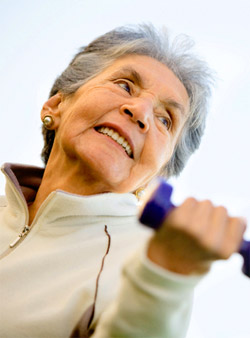
It has been observed and now documented that exercising critically ill patients may help speed recovery. The intensive care unit is a last frontier for physical therapy: Its hard to exercise patients hooked to ventilators. Some hospitals do manage to help critically ill patients stand or walk even if theyre tethered to life support. Now research that put sick mice on tiny treadmills shows why even a little activity may help speed recovery.
I think we can do a better job of implementing early mobility therapies, said Dr. D. Clark Files of Wake Forest Baptist Medical Center in Winston-Salem, North Carolina, who led the research and whose hospital is trying to get more critically ill patients up, ventilator and all. In the intensive care unit at Wake Forest Baptist Medical Center, physical therapist Katie Kellner helps patient Terry Culler do some exercises and briefly stand despite being hooked to a ventilator. Theres increasing evidence that mild exercise may have its place even for the sickest ICU patients, and new animal research suggests it may target both muscles and lungs.
Hospitals have long nudged less critical patients out of bed, to prevent their muscles from wasting away. But over the past several years, studies in ICUs have shown that some of the sickest of the sick also could benefit getting out of intensive care sooner, with fewer complications once its medically feasible for them to try.
This isnt just passively changing a patients position. It could involve helping them sit on the side of the bed, do arm exercises with an elastic band or in-bed cycling, even walk a bit with nurses holding all the tubes and wires. It takes extra staff, and especially for patients breathing through tubes down their throats, it isnt clear how often its attempted outside specialized centers.
At Wake Forest Baptist, a physical therapist helped Terry Culler, 54, do arm and leg exercises without dislodging his ventilator tubing, working up to the day he stood for the first time since developing respiratory failure about three weeks earlier. I cheered, I was clapping, his wife, Ruanne Culler of Lexington, North Carolina, said after two therapists and a nurse finally helped him to his feet.
Biologically, why could such mild activity help? Files focused on one especially deadly reason why people wind up on a ventilator: acute respiratory distress syndrome, or ARDS, the problem Terry Culler battled. It strikes about 200,000 Americans a year, usually after someone suffers serious injuries or another illness such as pneumonia; it can rapidly trigger respiratory failure. Survivors suffer profound muscle weakness.
Files team injured the lungs of laboratory mice in a way that triggered ARDS. The animals, sick but still breathing on their own, walked or ran on a treadmill for a few minutes at a time over two days. That short amount of exercise did more than counter wasting of the animals limbs. It also slowed weakening of the diaphragm, used to breathe. And it tamped down a dangerous inflammatory process in the lungs that Files suspects fuels muscle damage on top of the wasting of enforced bed-rest.
Its not only putting a load on the legs, Files explained. Its something systemic. When certain white blood cells stick inside ARDS-affected lungs too long, they slow healing. The lungs of the exercised mice contained fewer of those cells and their blood contained less of the protein that activates them, Files reported in the journal Science Translational Medicine this month.
Examining blood frozen from ARDS patients who had participated in an earlier Wake Forest Baptist study comparing early mobility to standard ICU care, he found patients who had gotten a little exercise harbored less of that protein. The new research adds to the biologic rationale, but theres already enough evidence supporting early mobility that families should ask whether their loved one is a candidate, said ICU specialist Dr. Catherine Hough of the University of Washington, who wasnt involved with Files study.
Shes surveying a sample of U.S. hospitals and finding variability in how often ICUs try, from those that help a majority of critically ill patients stand to others where no ventilated patients do. Obviously, key is whether the patient can tolerate movement. But so is whether hospitals keep ventilated patients sedated despite research showing many dont need to be, Hough said.
Back at Wake Forest Baptist, Terry Culler began the exercises when he was medically stable, and he scribbled notes saying he wanted to participate. Its given him something to look forward to, his wife said a few weeks before he was released from the hospital. Ask about it every day, University of Washingtons Hough advises families, given that critical illness changes frequently. On Monday, the patient might have a good reason not to be moving forward with mobilization, but theres a very good chance its different on Tuesday, she said.